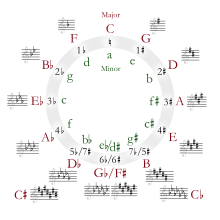Circle of thirds
In music theory, the circle of thirds, also known as the cycle of thirds, is a way of organizing pitches, and is a foundational pattern in music. This cycle is expressed through a sequence of 24 keys and therefore notes, which are changed by shifting up or down by a major or minor third. This in turn will lead to a noticeable visual pattern (a circle) and an auditory pattern (interconnected pitches), which are derived from the chromatic scale. Starting from C, the cycle goes as follows: C, Em, G, Bm, D, F♯m, A, C♯m, E, G♯, B, D♯m, F♯/G♭, B♭m, D♭, Fm, A♭, Cm, E♭, Gm, B♭, Dm, F, Am, and back to C.[1][a]
The circle of thirds is formed by placing the notes of a major or minor scale in order of thirds, instead of in their ascending order of scale degrees. In other words, this pattern is not dependent on a position within a scale, rather a sequence of thirds. When in a key other than C, the sequence will not start from C, but it will still be in the same overall order when viewed as a circle.[2]
History[edit]
Origins[edit]
The concept of a "circle of thirds" is relatively new in the history of music. Although certainly not the first to use it, a popular American jazz musician named John Coltrane often used a cycle composed of a sequence of major thirds for his unique key changes, hence the namesake for "coltrane changes". His popularity during the 1960s, especially with his albums such as Bags & Trane, brought much light to the augmented triads, and at the same time, the concept of a cycle of thirds. This conception was mainly inspired by "coltrane changes", albeit more developed.[3][4]
Although the exact date when the term "circle of thirds" was coined is not known, it was likely that it was shortly after John Coltrane's death in 1967. Nevertheless, the circle of thirds and Coltrane changes continue to be used in many jazz songs to this day, and by extent all of music.[4]
Structure and modern usage[edit]
Scales[edit]
The circle of thirds, although not nearly as popular as the circle of fifths, nevertheless has potential as a useful tool. In particular, this cycle can be used as a visual tool that help one remember the order of thirds, minor and major in a scale, and by extension the notes of any chords on any given major or minor scale.[2]
On top of all that, the cycle of thirds can also be a useful tool on understanding the connection between relative keys. Because as mentioned below, the cycle of thirds is just the major keys of the circle of fifths integrated with their relative minors, and every key has a common key signature with another key. Thus, one can get a decent picture of all relative keys and their key signatures in musical notation.
Chords[edit]

In music, the circle of thirds can be a useful asset for creating chords, and thence triads and arpeggios. This is because many chords are built on minor and major thirds. For instance, major chords are constructed by the unity of the major third and minor third intervals, while minor chords are based on a minor third and a major third, diminished chords are two minor thirds, and augmented chords are two major thirds.[b]
For a more practical example, consider the C major triad, which is just the sum of the notes C, E, G, in any order. The distance (interval) between C and E is four half steps, thus a major third.[5] The interval between E and G is 3 half steps, thus is a minor third. As mentioned in the paragraph below, the combination of a minor third and major third is the same as a perfect fifth, therefore completing all that is necessary for creating a C major chord which is the root note (C), and the following intervals, major third (E), and perfect fifth (G). This applies to the other chord kinds mentioned earlier, the only differences being how their constructed and arranged.

Other uses[edit]
Circle of fifths[edit]
The circle of fifths can act as a subset of the circle of thirds. This is because combining a major third (4 half steps/2 whole steps) with a minor third (3 half steps), will create a perfect fifth (7 half steps). Therefore, a sequence of counting every other note in the pattern in cycle of thirds, will constitute the circle of fifths.[1] In other words, if one integrates the major keys with their relative minors (which are minor thirds), one will get a model of the circle of thirds with the circle of fifths included.[1]
Chord progressions[edit]
The circle of thirds can be a value asset in gaining insight into chord progressions. For how and why this is, one could look at the key of C, and the chord progression I—IV—V. Starting from C, the progression goes as follows, C—F—G. In the circle of thirds, F is two steps away counter-clockwise from C, and G is also two steps from C, but clockwise. No matter what key one starts from, they will achieve the same pattern as long it's the same chord progression.
See also[edit]
References[edit]
Citations[edit]
- ^ a b c "Bracker Whistles & Flutes". music.bracker.uk. Retrieved 2024-01-30.
- ^ a b "Circle of Thirds: Visual Tool for Chords in Major or Minor Scales". muted.io. Retrieved 2024-01-31.
- ^ Marie, Yona (August 9, 2021). "Circle of Thirds - Is it a Thing?". Yona Marie Music.
- ^ a b "Coltrane Changes Explained". TJPS. Retrieved 2024-01-31.
- ^ "Music Theory Fundamentals 4: Triads on Guitar". Notes on a Guitar. 2021-11-17. Retrieved 2024-02-06.
